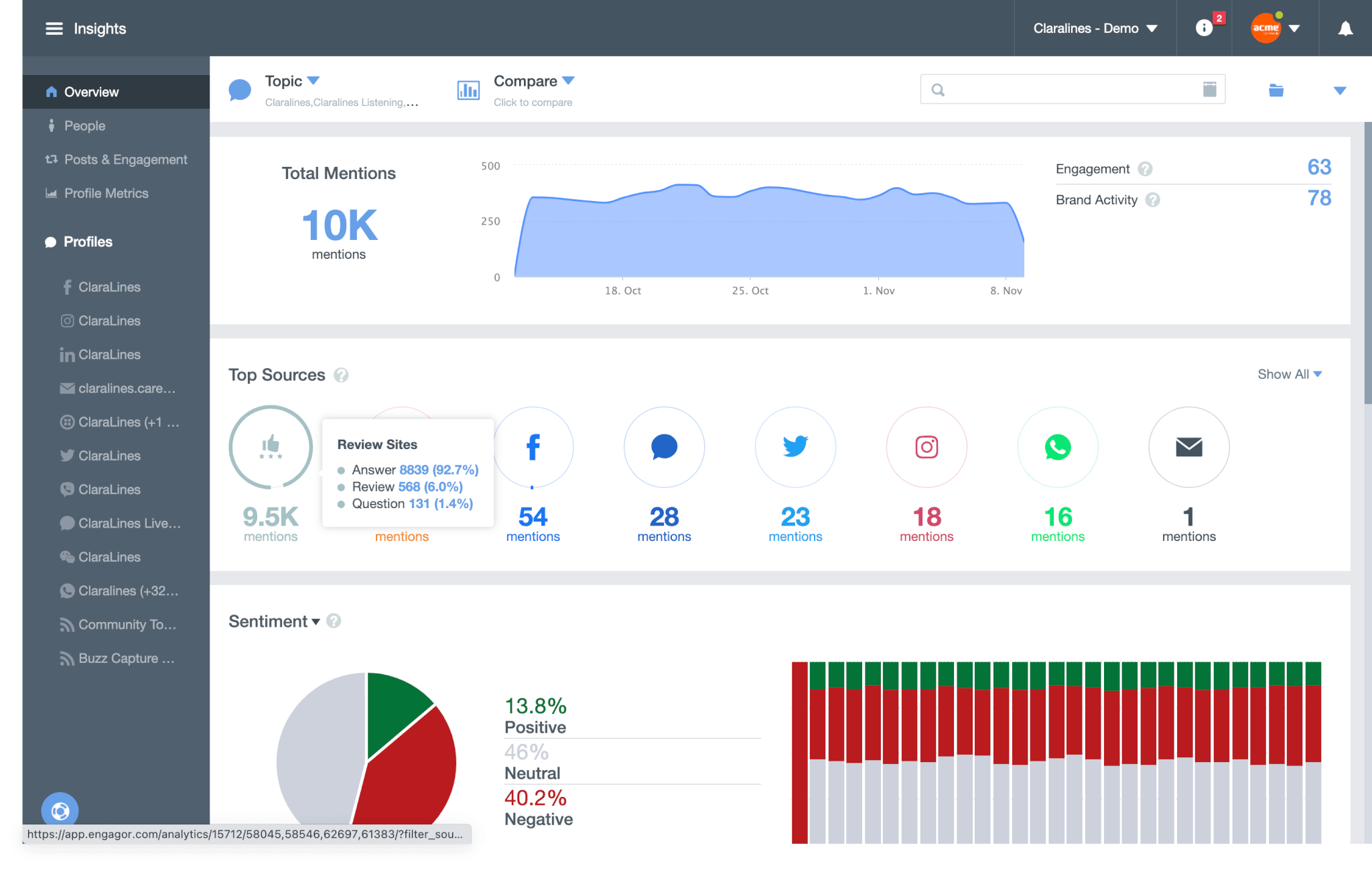In today’s digital era, social media has become an integral part of our daily lives. Individuals and businesses alike rely on social media platforms to connect, share, and engage with others. For brands, social media presents a unique opportunity to understand consumer sentiment, analyze market trends, and strengthen their brand presence. In this article, we will explore the concept of social media brand analysis and how it can help businesses make data-driven decisions to enhance their brand strategy.
Understanding Social Media Brand Analysis

Social media brand analysis involves a comprehensive examination of a brand’s social media presence, including its content strategy, audience engagement, sentiment analysis, competitor analysis, and advertising campaigns. By conducting a thorough analysis, brands can gain valuable insights into their brand perception, audience sentiment, and the effectiveness of their marketing initiatives.
Key Metrics for Social Media Brand Analysis
When analyzing a brand’s social media performance, several key metrics come into play. These metrics include:
1. Follower Growth and Engagement
- Measuring the growth of followers and the level of engagement helps determine the brand’s reach and popularity. By tracking metrics such as likes, comments, shares, and retweets, brands can assess how well their content resonates with their audience.
2. Reach and Impressions
- Reach and impressions provide an overview of how many people have seen a brand’s content. These metrics highlight the potential visibility of the brand’s messaging and the effectiveness of its social media strategy.
3. Sentiment Analysis
- By analyzing sentiment, brands can gauge the overall perception of their brand among their audience. Positive sentiment indicates a strong brand reputation, while negative sentiment may signal the need for reputation management strategies.
4. Share of Voice
- Share of voice measures a brand’s visibility compared to its competitors. It helps brands understand their market share and identify opportunities for growth or areas that need improvement.
5. Conversion Rate
- Monitoring the conversion rate enables brands to measure the effectiveness of their social media efforts in driving desired actions, such as website visits, lead generation, or sales.
Tools for Social Media Brand Analysis
To conduct effective social media brand analysis, brands can leverage various tools and platforms designed specifically for this purpose. Some popular tools include:
1. Social Mention
- Social Mention is a real-time social media search engine that monitors brand mentions and sentiment across multiple platforms. It provides an overview of a brand’s online reputation and helps identify influential conversations related to the brand.
2. Sprout Social
- Sprout Social is a comprehensive social media management platform that offers robust analytics and reporting capabilities. It allows brands to track key metrics, schedule content, and engage with their audience effectively.
3. Aim Insights
- AIM Insights is a powerful social listening tool that enables brands to monitor and analyze conversations around their brand. It provides valuable insights into audience sentiment, emerging trends, and competitor activities.
4. Google Analytics
- Google Analytics offers in-depth website analytics, including traffic sources, user behavior, and conversions. By integrating social media data with Google Analytics, brands can gain a holistic view of their online performance.
5. Hootsuite
- Hootsuite is a popular social media management tool that enables brands to manage multiple social media accounts, schedule posts, and monitor brand mentions. It provides valuable analytics to assess the impact of social media efforts.
Steps to Conduct a Social Media Brand Analysis

Conducting a social media brand analysis involves a systematic approach to gathering and interpreting data effectively. Here are the essential steps to perform a comprehensive analysis:
1. Set Clear Objectives
- Define specific goals and objectives for the analysis. Identify the key areas of focus, such as brand perception, audience engagement, or competitor benchmarking.
2. Identify Relevant Metrics
- Select the metrics that align with the defined objectives. Determine which metrics are most relevant to evaluate the brand’s performance and impact.
3. Gather Data
- Collect data from various social media platforms and relevant tools. Ensure the data collected is accurate, consistent, and covers the desired period.
4. Analyze and Interpret Data
- Analyze the gathered data to gain insights into the brand’s performance. Look for patterns, trends, and areas of improvement. Interpret the data in the context of the defined objectives.
5. Draw Actionable Insights
- Based on the analysis, draw actionable insights that can inform future brand strategies. Identify opportunities to optimize content, engage with the audience, or refine marketing campaigns.
6. Monitor and Iterate
- Continuously monitor the brand’s social media performance and iterate the analysis process accordingly. Social media trends and audience behaviors evolve rapidly, requiring brands to stay proactive and adaptable.
Assessing Social Media Engagement
Engagement metrics on social media platforms reflect the level of interaction and interest from the audience. Brands can evaluate engagement through metrics such as likes, comments, shares, and clicks. By analyzing engagement patterns, brands can tailor their content strategy to increase engagement and foster meaningful connections with their audience.
Measuring Social Media Influence
Influencer marketing has become a powerful tool for brands to amplify their message and reach a wider audience. By analyzing the influence of individuals or social media accounts, brands can identify potential partnerships, assess the impact of influencer campaigns, and measure the return on investment.
Monitoring Competitor Brands on Social Media
Competitor analysis is vital for understanding market dynamics and gaining a competitive edge. By monitoring competitor brands on social media, businesses can identify their strategies, assess their performance, and uncover opportunities or gaps in the market. This analysis helps brands position themselves strategically and differentiate their offerings.
Utilizing User-generated Content for Brand Analysis
User-generated content (UGC) has gained significant traction as an authentic and influential form of brand promotion. By analyzing UGC, brands can understand how customers perceive and interact with their products or services. UGC analysis provides valuable insights into consumer preferences, brand loyalty, and potential areas for improvement.
Leveraging Sentiment Analysis for Brand Evaluation
Sentiment analysis involves using natural language processing techniques to determine the sentiment or emotional tone behind social media conversations. By analyzing sentiment, brands can understand how their audience feels about their brand, products, or services. This analysis helps brands identify areas of strength, address customer concerns, and refine their brand messaging.
Analyzing Social Media Advertising Campaigns
Social media advertising campaigns can significantly impact brand awareness, reach, and conversions. By analyzing the performance of advertising campaigns, brands can optimize their targeting, ad formats, and messaging to maximize the return on investment. Through data-driven analysis, brands can allocate their advertising budgets effectively and make informed decisions.
Enhancing Brand Strategy through Social Media Brand Analysis
A well-executed social media brand analysis provides brands with valuable insights that can enhance their overall brand strategy. By leveraging data and analytics, brands can refine their content strategy, strengthen their online presence, and create engaging experiences for their audience. Social media brand analysis helps businesses make informed decisions, stay competitive, and foster long-term brand growth.
Case Studies of Record-Breaking Social Media Campaigns
Incorporating case studies of brands that have broken records on social media offers insight into successful strategies and tactics that have resonated with audiences. Here are a few notable examples:
- Nike’s “Dream Crazy” Campaign
Nike’s “Dream Crazy” campaign featuring Colin Kaepernick sparked widespread conversation on social media. The campaign quickly went viral, leading to a record-breaking surge in Nike’s engagement. According to Brandwatch, Nike’s online mentions increased by 1,678% within 24 hours of the campaign launch. The brand’s bold approach attracted both praise and criticism, but ultimately strengthened Nike’s connection with a loyal, engaged audience. - Coca-Cola’s #ShareACoke Campaign
Coca-Cola’s #ShareACoke campaign personalized Coke bottles with names, inspiring millions to share their experiences on social media. By leveraging user-generated content (UGC), Coca-Cola achieved unparalleled engagement, with over 500,000 photos shared using the campaign hashtag on Instagram. The campaign’s success showcased the power of personalized marketing and social sharing. - Wendy’s Twitter Roasts
Wendy’s embraced a unique, witty voice on Twitter, engaging audiences with playful roasts and responses to fans and competitors alike. A notable tweet where Wendy’s playfully criticized McDonald’s amassed over 250,000 likes, further boosting their brand’s visibility. Wendy’s ongoing Twitter success highlights the value of brand personality and authenticity in engaging a digital audience.
Influencer Quotes and Tweets
Including influencer perspectives and popular quotes further illustrates the value of social media analysis. Here are some insights from industry leaders:
- Gary Vaynerchuk (@garyvee) – Entrepreneur and social media expert
“Social media gives everyone a voice, but only the brands that truly listen and engage with their audience will succeed. Don’t just post – connect and build real relationships.”- Mari Smith (@MariSmith) – Social media thought leader
“Engagement is the heart of social media marketing. Without engagement, even the best content will fall flat. Brands that focus on meaningful interactions will win.”- Neil Patel (@neilpatel) – Digital marketing expert
“Data-driven decisions are the backbone of any successful social media strategy. Analyzing your metrics gives you a roadmap for improvement and helps you stay relevant.”- Jay Baer (@jaybaer) – Author and marketing speaker
“Customer expectations are sky-high on social. People expect brands to respond quickly, authentically, and humanly. If you’re not doing that, you’re falling behind.”
Conclusion
Social media brand analysis is a powerful tool for businesses to gain insights, measure performance, and refine their brand strategies. By understanding key metrics, leveraging analytical tools, and following a systematic analysis process, brands can unlock valuable insights that shape their online presence. Embracing social media brand analysis empowers businesses to make data-driven decisions, engage with their audience effectively, and stay ahead in a dynamic digital landscape.
If you’re ready to take your brand analysis to the next level, request a demo from AIM Technologies. Our innovative platform combines advanced analytics and intuitive features to help you extract actionable insights from social media data. Don’t miss out on the opportunity to enhance your brand strategy and drive meaningful results.
FAQs
1. Why is social media brand analysis important for businesses?
- Social media brand analysis helps businesses understand their audience, measure performance, and refine their brand strategies. It provides valuable insights into consumer sentiment, competitor activities, and the effectiveness of marketing initiatives.
2. How can social media brand analysis benefit brand perception?
- By analyzing brand mentions, sentiments, and conversations on social media, businesses can manage and improve their brand perception. It allows them to identify areas of strength, address negative sentiment, and align their messaging with audience expectations.
3. What are some key metrics for social media brand analysis?
- Key metrics for social media brand analysis include follower growth, engagement rates, reach and impressions, sentiment analysis, share of voice, and conversion rates. These metrics provide valuable insights into a brand’s online performance and impact.
4. What tools can businesses use for social media brand analysis?
- Some popular tools for social media brand analysis include Social Mention, Sprout Social, Aim Insights, Google Analytics, and Hootsuite. These tools offer analytics, monitoring, and reporting features to help businesses gather and interpret social media data effectively.
5. How often should businesses conduct social media brand analysis?
- Social brand analysis should be conducted regularly to stay updated on market trends, audience behaviors, and competitor activities. It is recommended to perform analysis on a monthly or quarterly basis, depending on the business’s size and industry.




